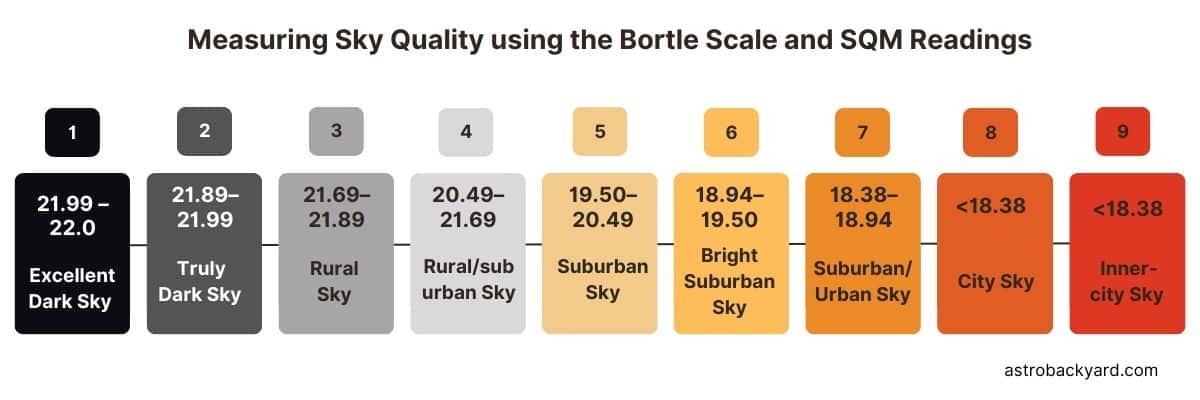Glossary |
Bortle Scale |
updated: 2025-04-29 |
Bortle is a tool for an observer to evaluate the specific ambient light conditions at a particular location. In contrast, SQM (Sky Quality Meter) measures the actual brightness of the sky, including clouds, haze, and light reflection in the sky, and can vary rapidly with time and the orientation of the measuring device.

credit: https://astrobackyard.com/wp-content/uploads/2023/04/Measuring-Sky-Quality.jpg
The Bortle scale is a nine-level numeric scale that measures the night sky's brightness of a particular location. It quantifies the astronomical observability of celestial objects and the interference caused by light pollution. John E. Bortle created the scale and published it in the February 2001 edition of Sky & Telescope magazine to help amateur astronomers evaluate the darkness of an observing site, and secondarily, to compare the darkness of observing sites.
The scale ranges from Class 1, the darkest skies available on Earth, through Class 9, inner-city skies. It gives several criteria for each level beyond naked-eye limiting magnitude (NELM). The accuracy and utility of the scale have been questioned in recent research.[2]
Influence of the Bortle value on astrophotography
"Amateur astrophotographers have come up with a simple formula to correlate total exposure time and Bortle scale. It's said that 2.25 X the amount of total integration is needed to collect as much signal from one Bortle Scale class below the one you're shooting in. For example, to collect 2 hours of quality signal from a Bortle Scale 5 sky, I would need to collect 4.5 hours of total exposure time. This is not an exact formula, but a useful rule of thumb."
(credit: Find Your Night Sky Brightness on the Bortle Scale | Real Life Examples (astrobackyard.com))
Tools for displaying the Bortle scale or Light Pollution Maps
- see Light Pollution Maps (in this guide)
References:
- SQM Sky Quality (in this guide)
- Bortle Scale (in Wikipedia)
- Dark Sky Awareness (Darkskiesawareness.org via WaybackMachine)
- Limiting magnitude (Wikipedia)
- Naked eye Limiting Magniture (Wikipedia)
- Weather Planning (in this guide)
- Rating Skies by SQM (Cloudy Nights)
- Bortle Scale, SQM and NELM (Wikipedia)
- Sky Quality Meter (Wikipedia)
- NELM (in this guide)
Created with the Personal Edition of HelpNDoc: Make the switch to CHM with HelpNDoc's hassle-free WinHelp HLP to CHM conversion tool
